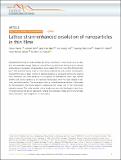Files in this item
Lattice strain-enhanced exsolution of nanoparticles in thin films
Item metadata
| dc.contributor.author | Han, Hyeon | |
| dc.contributor.author | Park, Jucheol | |
| dc.contributor.author | Nam, Sang Yeol | |
| dc.contributor.author | Choi, Gyeong Man | |
| dc.contributor.author | Parkin, Stuart S.P. | |
| dc.contributor.author | Jang, Hyun Myung | |
| dc.contributor.author | Irvine, John T. S. | |
| dc.date.accessioned | 2019-04-01T12:30:21Z | |
| dc.date.available | 2019-04-01T12:30:21Z | |
| dc.date.issued | 2019-12-01 | |
| dc.identifier | 258154289 | |
| dc.identifier | ce21ebc2-a3e1-4a96-84f7-e504c0719c3f | |
| dc.identifier | 85063751779 | |
| dc.identifier | 000462858400003 | |
| dc.identifier.citation | Han , H , Park , J , Nam , S Y , Choi , G M , Parkin , S S P , Jang , H M & Irvine , J T S 2019 , ' Lattice strain-enhanced exsolution of nanoparticles in thin films ' , Nature Communications , vol. 10 , 1471 . https://doi.org/10.1038/s41467-019-09395-4 | en |
| dc.identifier.issn | 2041-1723 | |
| dc.identifier.other | ORCID: /0000-0002-8394-3359/work/68280616 | |
| dc.identifier.uri | https://hdl.handle.net/10023/17412 | |
| dc.description | This work was supported by the National Research Foundation (NRF) Grant funded by the Korean Government (MSIP Grant No.2016R 1D1A1B 03933253). J.T.S.I. thanks the EPSRC for support on emergent nanomaterials through grant EP/R023522/1. H.H. and S.S.P.P. acknowledge the support by the Max Planck Society (MPG). | en |
| dc.description.abstract | Nanoparticles formed on oxide surfaces are of key importance in many fields such as catalysis and renewable energy. Here, we control B-site exsolution via lattice strain to achieve a high degree of exsolution of nanoparticles in perovskite thin films: more than 1100 particles μm−2 with a particle size as small as ~5 nm can be achieved via strain control. Compressive-strained films show a larger number of exsolved particles as compared with tensile-strained films. Moreover, the strain-enhanced in situ growth of nanoparticles offers high thermal stability and coking resistance, a low reduction temperature (550 oC), rapid release of particles, and wide tunability. The mechanism of lattice strain-enhanced exsolution is illuminated by thermodynamic and kinetic aspects, emphasizing the unique role of the misfit-strain relaxation energy. This study provides critical insights not only into the design of new forms of nanostructures but also applications ranging from catalysis, energy conversion/storage, nano-composites, nano-magnetism, to nano-optics. | |
| dc.format.extent | 8 | |
| dc.format.extent | 2251718 | |
| dc.language.iso | eng | |
| dc.relation.ispartof | Nature Communications | en |
| dc.subject | QD Chemistry | en |
| dc.subject | NDAS | en |
| dc.subject | SDG 7 - Affordable and Clean Energy | en |
| dc.subject.lcc | QD | en |
| dc.title | Lattice strain-enhanced exsolution of nanoparticles in thin films | en |
| dc.type | Journal article | en |
| dc.contributor.sponsor | EPSRC | en |
| dc.contributor.institution | University of St Andrews. Centre for Designer Quantum Materials | en |
| dc.contributor.institution | University of St Andrews. School of Chemistry | en |
| dc.contributor.institution | University of St Andrews. EaSTCHEM | en |
| dc.identifier.doi | https://doi.org/10.1038/s41467-019-09395-4 | |
| dc.description.status | Peer reviewed | en |
| dc.identifier.grantnumber | EP/R023522/1 | en |
This item appears in the following Collection(s)
Items in the St Andrews Research Repository are protected by copyright, with all rights reserved, unless otherwise indicated.

